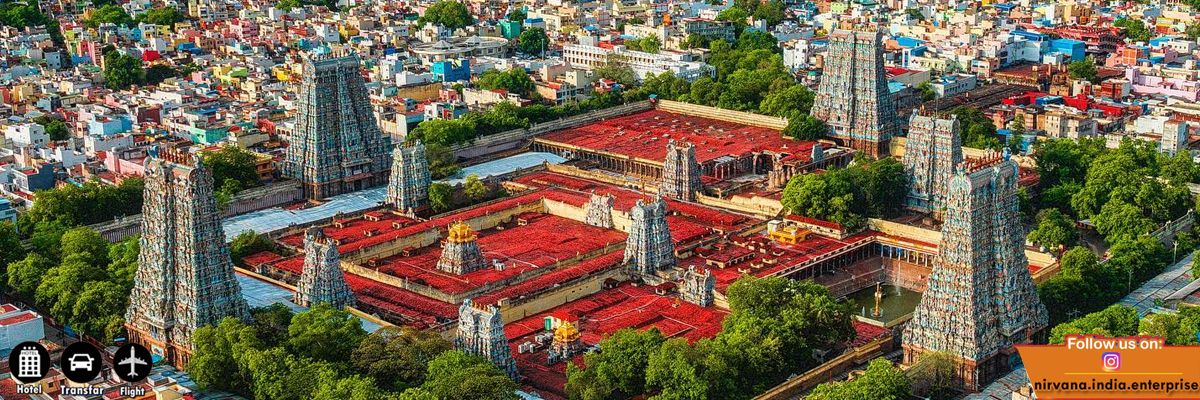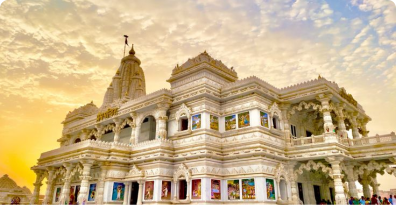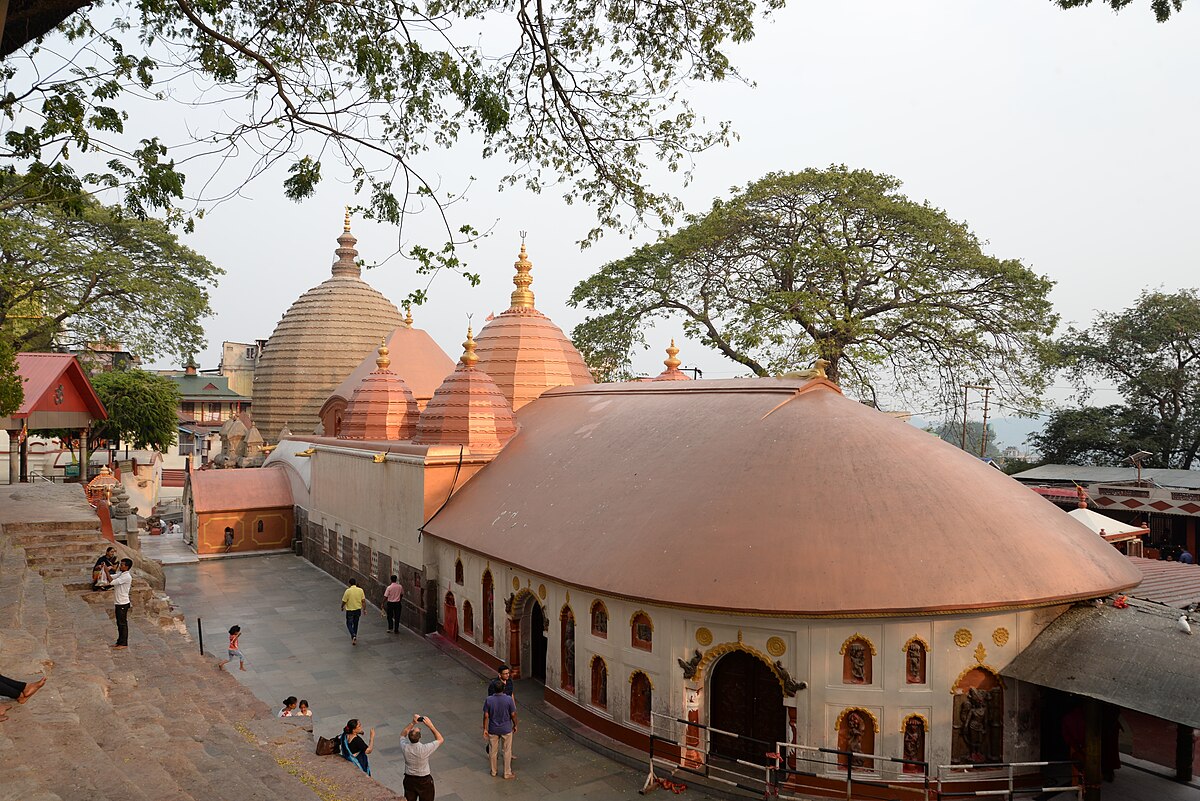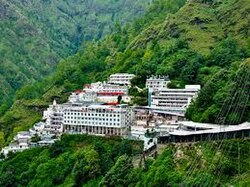
October 06, 2025
Temple Mandir
6 min read
Meenakshi Temple
Located in the heart of Madurai, Tamil Nadu, the Meenakshi Temple is a spectacular blend of devotion, art, and history. Dedicated to Goddess Meenakshi, an incarnation of Parvati, and Lord Sundareswarar, an aspect of Shiva, this temple is famed for its towering gopurams (gateway towers) adorned with thousands of intricate sculptures. Steeped in legends, it is believed that Goddess Meenakshi rules over Madurai with divine grace, and her celestial marriage to Lord Sundareswarar symbolizes the union of power and compassion. Beyond its spiritual significance, the temple is a vibrant hub of festivals, rituals, and cultural traditions, drawing millions of pilgrims and art lovers from across the world. Visiting Meenakshi Temple is not just a religious experience—it’s a journey into the heart of Tamil heritage and timeless devotion.
Meenakshi Temple, Madurai: The Divine Abode of Goddess Meenakshi and Lord Sundareswarar
Introduction
The Meenakshi Temple, located in the historic city of Madurai, Tamil Nadu, is one of India’s most iconic and magnificent temples. Dedicated to Goddess Meenakshi (a form of Parvati) and her consort Lord Sundareswarar (Shiva), it is a symbol of divine love, cultural richness, and spiritual devotion.
Often called the “Athens of the East”, Madurai is renowned for its ancient traditions, literary heritage, and architectural marvels. The Meenakshi Temple lies at the heart of the city, attracting millions of devotees and tourists every year. Pilgrims believe that worshipping here fulfills desires, blesses with prosperity, and grants spiritual wisdom.
The temple is not only a religious center but also a cultural hub, hosting festivals, music, dance, and art that have thrived for centuries, making it a living embodiment of Tamil heritage.
Historical Background
The history of Meenakshi Temple stretches over 2,500 years, with its roots embedded in ancient Tamil literature such as the Sangam texts. According to legend, King Malayadwaja Pandya and his queen Kanchanamalai were childless for years and prayed fervently to Lord Shiva. Their prayers were answered with the birth of Meenakshi, a girl with three breasts, destined to be a great warrior and ruler.
When Meenakshi grew up, her third breast disappeared, signaling that she had found her divine consort, Lord Sundareswarar. Their celestial marriage forms the basis of many rituals and festivals at the temple, symbolizing the union of divine masculine and feminine energies.
Historically, the temple has been expanded and rebuilt by several dynasties, most notably the Nayaks of Madurai in the 16th and 17th centuries. Architecturally, it showcases Dravidian style, with towering gopurams (gateway towers), intricately carved mandapams (halls), and majestic sanctums that highlight the artistic brilliance of Tamil artisans.
The Meenakshi Nayakar Mandapam and Aayiram Kaal Mandapam (Hall of Thousand Pillars) are particularly famous, with each pillar adorned with unique sculptures depicting stories from Hindu epics.
Myths & Stories
Meenakshi Temple is steeped in mythology, divine stories, and folklore. One of the most famous legends is the divine birth of Meenakshi, who was destined to conquer kingdoms and defeat evil. As a warrior goddess, she went on numerous campaigns, teaching righteousness and justice.
Another popular tale is the divine marriage of Meenakshi and Sundareswarar, which is celebrated annually as the Chithirai Festival, attracting millions of devotees. This festival symbolizes cosmic harmony, the union of Shakti (energy) and Shiva (consciousness), which is central to Shaivism philosophy.
The temple is also linked to the story of Vishnu’s visit to Madurai, where he praised the goddess for her bravery and devotion, further cementing the temple’s status as a pan-Hindu spiritual center.
Locals also recount miracles where devotees’ prayers were answered instantly, and stories of divine intervention during invasions have been passed down through generations, creating an aura of mystical presence and spiritual power.
Festivals & Rituals
Meenakshi Temple is alive with festivals and daily rituals that attract devotees and tourists alike. The most famous festival is the Chithirai Thiruvizha (April–May), a grand celebration of Meenakshi-Sundareswarar’s celestial marriage. The festival includes processions, music, traditional dance performances, and temple ceremonies, making the city vibrate with devotion.
Another important festival is Navaratri, celebrating Goddess Meenakshi’s feminine energy. During this time, the temple is beautifully decorated, and special rituals are conducted, including Alankaram (decorating the deity), Abhishekam, and cultural performances.
Daily rituals at the temple are meticulously performed. The temple opens with Suprabhatam (morning awakening of the deity), followed by Archana, Abhishekam, and Maha Aarti. The priests chant Vedic hymns while performing rituals with flowers, holy water, and sacred fire, creating an intense spiritual ambiance.
A unique ritual at Meenakshi Temple is the “Vahana Seva”, where the deity is placed on a sacred mount (vahana) and paraded through the temple streets. This ritual is considered highly auspicious and is believed to bestow blessings upon devotees.
Visitor Experience
Visiting Meenakshi Temple is a mesmerizing journey through history, spirituality, and culture. The temple is situated in the heart of Madurai city, making it easily accessible for both domestic and international tourists.
The massive gopurams, towering up to 170 feet, are covered with colorful sculptures of gods, demons, and mythological creatures, providing a visual treat even before entering the temple. Inside, the Aayiram Kaal Mandapam (Hall of Thousand Pillars) impresses visitors with its exquisite craftsmanship, where each pillar is intricately carved and unique.
Visitors should plan for early morning darshan to avoid large crowds, especially during festivals. Photography is restricted inside the sanctum but allowed in other areas of the temple complex. Guided tours are available, providing insights into mythology, temple architecture, and cultural significance.
Nearby attractions include Thirumalai Nayak Palace, Vandiyur Mariamman Teppakulam (temple tank), and Gandhi Memorial Museum, offering a complete experience of Madurai’s heritage.
For pilgrims, the temple prasadams, local delicacies like parotta, jigarthanda, and pongal, and the spiritual ambiance make the visit truly unforgettable.
Spiritual Significance
Meenakshi Temple holds profound spiritual significance, representing the divine union of energy and consciousness. Devotees believe that worshipping here removes obstacles, grants wisdom, and brings prosperity. The goddess Meenakshi embodies strength, courage, and compassion, while Lord Sundareswarar represents inner consciousness and divine protection.
The temple’s location in Madurai, a city considered sacred since Sangam times, enhances its spiritual aura. Pilgrims often experience inner calm, divine inspiration, and heightened devotion upon visiting.
The temple also serves as a cultural beacon, preserving traditional Tamil arts, classical music, and dance forms through its festivals and daily rituals. This blend of spirituality and culture makes the Meenakshi Temple a unique destination where faith, art, and history coexist harmoniously.
Conclusion
The Meenakshi Temple of Madurai is not just a place of worship; it is a living symbol of devotion, art, and cultural heritage. From its mythical origins and divine tales to its grand architecture and vibrant festivals, the temple continues to inspire and captivate devotees and visitors alike.
A visit to this temple is a journey into the heart of Tamil spirituality, where one can witness the magnificence of divine love, courage, and wisdom. Whether you are seeking spiritual solace, cultural immersion, or architectural marvels, Meenakshi Temple offers an experience that resonates for a lifetime.
The temple, with its towering gopurams, sacred rituals, and timeless legends, reminds us of the eternal dance of the divine, where energy and consciousness unite to guide humanity toward faith, devotion, and enlightenment.
Introduction
The Meenakshi Temple, located in the historic city of Madurai, Tamil Nadu, is one of India’s most iconic and magnificent temples. Dedicated to Goddess Meenakshi (a form of Parvati) and her consort Lord Sundareswarar (Shiva), it is a symbol of divine love, cultural richness, and spiritual devotion.
Often called the “Athens of the East”, Madurai is renowned for its ancient traditions, literary heritage, and architectural marvels. The Meenakshi Temple lies at the heart of the city, attracting millions of devotees and tourists every year. Pilgrims believe that worshipping here fulfills desires, blesses with prosperity, and grants spiritual wisdom.
The temple is not only a religious center but also a cultural hub, hosting festivals, music, dance, and art that have thrived for centuries, making it a living embodiment of Tamil heritage.
Historical Background
The history of Meenakshi Temple stretches over 2,500 years, with its roots embedded in ancient Tamil literature such as the Sangam texts. According to legend, King Malayadwaja Pandya and his queen Kanchanamalai were childless for years and prayed fervently to Lord Shiva. Their prayers were answered with the birth of Meenakshi, a girl with three breasts, destined to be a great warrior and ruler.
When Meenakshi grew up, her third breast disappeared, signaling that she had found her divine consort, Lord Sundareswarar. Their celestial marriage forms the basis of many rituals and festivals at the temple, symbolizing the union of divine masculine and feminine energies.
Historically, the temple has been expanded and rebuilt by several dynasties, most notably the Nayaks of Madurai in the 16th and 17th centuries. Architecturally, it showcases Dravidian style, with towering gopurams (gateway towers), intricately carved mandapams (halls), and majestic sanctums that highlight the artistic brilliance of Tamil artisans.
The Meenakshi Nayakar Mandapam and Aayiram Kaal Mandapam (Hall of Thousand Pillars) are particularly famous, with each pillar adorned with unique sculptures depicting stories from Hindu epics.
Myths & Stories
Meenakshi Temple is steeped in mythology, divine stories, and folklore. One of the most famous legends is the divine birth of Meenakshi, who was destined to conquer kingdoms and defeat evil. As a warrior goddess, she went on numerous campaigns, teaching righteousness and justice.
Another popular tale is the divine marriage of Meenakshi and Sundareswarar, which is celebrated annually as the Chithirai Festival, attracting millions of devotees. This festival symbolizes cosmic harmony, the union of Shakti (energy) and Shiva (consciousness), which is central to Shaivism philosophy.
The temple is also linked to the story of Vishnu’s visit to Madurai, where he praised the goddess for her bravery and devotion, further cementing the temple’s status as a pan-Hindu spiritual center.
Locals also recount miracles where devotees’ prayers were answered instantly, and stories of divine intervention during invasions have been passed down through generations, creating an aura of mystical presence and spiritual power.
Festivals & Rituals
Meenakshi Temple is alive with festivals and daily rituals that attract devotees and tourists alike. The most famous festival is the Chithirai Thiruvizha (April–May), a grand celebration of Meenakshi-Sundareswarar’s celestial marriage. The festival includes processions, music, traditional dance performances, and temple ceremonies, making the city vibrate with devotion.
Another important festival is Navaratri, celebrating Goddess Meenakshi’s feminine energy. During this time, the temple is beautifully decorated, and special rituals are conducted, including Alankaram (decorating the deity), Abhishekam, and cultural performances.
Daily rituals at the temple are meticulously performed. The temple opens with Suprabhatam (morning awakening of the deity), followed by Archana, Abhishekam, and Maha Aarti. The priests chant Vedic hymns while performing rituals with flowers, holy water, and sacred fire, creating an intense spiritual ambiance.
A unique ritual at Meenakshi Temple is the “Vahana Seva”, where the deity is placed on a sacred mount (vahana) and paraded through the temple streets. This ritual is considered highly auspicious and is believed to bestow blessings upon devotees.
Visitor Experience
Visiting Meenakshi Temple is a mesmerizing journey through history, spirituality, and culture. The temple is situated in the heart of Madurai city, making it easily accessible for both domestic and international tourists.
The massive gopurams, towering up to 170 feet, are covered with colorful sculptures of gods, demons, and mythological creatures, providing a visual treat even before entering the temple. Inside, the Aayiram Kaal Mandapam (Hall of Thousand Pillars) impresses visitors with its exquisite craftsmanship, where each pillar is intricately carved and unique.
Visitors should plan for early morning darshan to avoid large crowds, especially during festivals. Photography is restricted inside the sanctum but allowed in other areas of the temple complex. Guided tours are available, providing insights into mythology, temple architecture, and cultural significance.
Nearby attractions include Thirumalai Nayak Palace, Vandiyur Mariamman Teppakulam (temple tank), and Gandhi Memorial Museum, offering a complete experience of Madurai’s heritage.
For pilgrims, the temple prasadams, local delicacies like parotta, jigarthanda, and pongal, and the spiritual ambiance make the visit truly unforgettable.
Spiritual Significance
Meenakshi Temple holds profound spiritual significance, representing the divine union of energy and consciousness. Devotees believe that worshipping here removes obstacles, grants wisdom, and brings prosperity. The goddess Meenakshi embodies strength, courage, and compassion, while Lord Sundareswarar represents inner consciousness and divine protection.
The temple’s location in Madurai, a city considered sacred since Sangam times, enhances its spiritual aura. Pilgrims often experience inner calm, divine inspiration, and heightened devotion upon visiting.
The temple also serves as a cultural beacon, preserving traditional Tamil arts, classical music, and dance forms through its festivals and daily rituals. This blend of spirituality and culture makes the Meenakshi Temple a unique destination where faith, art, and history coexist harmoniously.
Conclusion
The Meenakshi Temple of Madurai is not just a place of worship; it is a living symbol of devotion, art, and cultural heritage. From its mythical origins and divine tales to its grand architecture and vibrant festivals, the temple continues to inspire and captivate devotees and visitors alike.
A visit to this temple is a journey into the heart of Tamil spirituality, where one can witness the magnificence of divine love, courage, and wisdom. Whether you are seeking spiritual solace, cultural immersion, or architectural marvels, Meenakshi Temple offers an experience that resonates for a lifetime.
The temple, with its towering gopurams, sacred rituals, and timeless legends, reminds us of the eternal dance of the divine, where energy and consciousness unite to guide humanity toward faith, devotion, and enlightenment.


